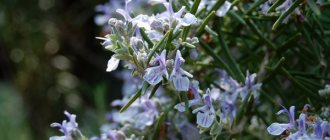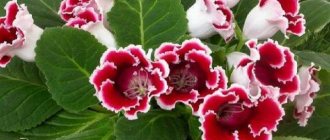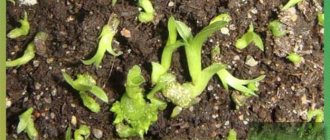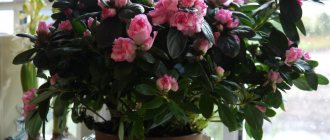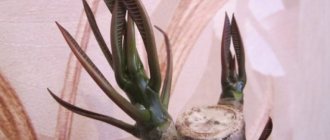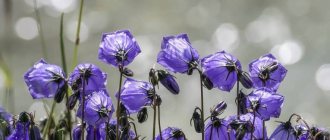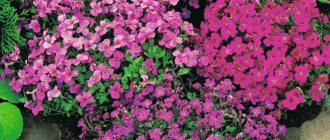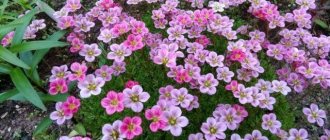HOW TO GROW SAXIFRAGY FROM SEEDS INDEPENDENTLY
You can start growing seedlings by listening to our advice. To prepare seeds for sowing in the fall:
- Wash the coarse river sand, dry it and sift it.
- Mix sand with seeds; it will prevent the seedlings from sprouting too thickly.
- Carry out stratification - cold treatment. It will speed up seed germination and allow you to get healthy and strong seedlings. The mixture of sand and seeds is placed in a shallow container, which should have a transparent lid to ensure the container is sealed. Sprinkle the seeds with a small amount of moistened sand on top and place the closed container in a cool place for approximately three weeks (at least two weeks).
Seed stratification can also be carried out by spreading them in a thin layer in containers pre-filled with soil. Then, after stratification, it is enough to place the containers in a bright place, provide an air temperature of 20 C and wait for germination. However, let's also consider a growing method in which the seeds are stratified without planting and then sown in a nutrient substrate.
Reproduction and planting
When planting and propagating Arends saxifrage, there are no special differences from other plants. You can grow flowers both on rocky, depleted soil and on fertile, well-fertilized soil.
Note! Excessive soil moisture leads to rotting of Arends' saxifrage.
It can grow both in the shade and in direct sun. The plant has no special whims, but the only thing that needs to be done regularly is watering.
Growing Arends saxifrage from seeds
In order for this amazing plant to bloom and delight its owners for a long time, it is necessary to follow certain rules when growing it from seeds.
Saxifraga White
Before sowing seeds, they need to be stratified. This is done for better germination. This procedure is performed in the following way:
- Mix the seeds with sand.
- Place the mixture in the refrigerator for two to three weeks.
Then you need to plant the seeds into seedlings. The next steps look like this:
- Prepare containers with a special mixture.
- Scald the soil with boiling water.
- Spread the seeds mixed with sand over the surface.
- There is no need to spray and cover the crops with film; there is no need to sprinkle with soil.
If all these steps are done correctly, then within 7-10 days the Arends saxifrage will produce its first shoots. Afterwards, stronger specimens with small leaves are dropped into peat pots.
Vegetative propagation
To grow a plant in this way, various factors must be taken into account. However, the method is quite easy and fast. To get good bushes, it is recommended:
- Cut off rooted shoots or shoots with aerial roots.
- Transplant to a new place with a lump of earth.
Note! Arends saxifrage shoots do not tolerate cold.
Shoots that are longer than 5 cm are later cut and divided into several parts. The plant must be rooted in water or peat soil, but this must be done indoors.
SOIL PREPARATION
There are three ways to sow seeds:
- In purchased soil.
- In peat tablets. To plant 2-3 seeds you will need 1 piece.
- In a self-prepared mixture.
Saxifraga is a typical calciphile, that is, it needs calcium for normal growth and development. Therefore, when preparing the soil mixture, it is necessary to add chalk or limestone to it. The soil should have approximately the following composition:
- 2 parts peat soil;
- 1 tsp sand;
- 0.5 tsp vermiculite;
- 0.1 tsp chalk.
Saxifraga: combination with other plants
Growing saxifrage will bring you tremendous pleasure. All their varieties look very original and impressive, especially in combination with other plants. Irises, muscari and many other low-growing crops can share their proximity. Amazing combinations of saxifrage with lingonberries or Chinese-decorated gentian will help fill your exterior with beauty and originality.
Saxifraga in landscape design
SOWING SEEDS
After stratification, the seeds are spread on the surface of the moist soil mixture. To avoid the appearance of mold on them, you should use containers with drainage holes, ventilate the containers twice a day and remove condensation from the lids. Until the seeds germinate, the crops do not need watering. The containers are covered with polyethylene or transparent lids and taken out into the light, for example, placed on a windowsill. For seedlings to germinate, it is necessary to maintain the air temperature in the room at approximately 20 C. Provided that all rules for processing and germinating seeds are followed, the first shoots can be expected in another week.
Diseases and pests
Saxifraga is quite resistant to pests and diseases. However, unfavorable growing conditions or improper care can cause it to become infected or damaged by pests.
Dryness can cause damage to the plant by spider mites. In this case, a whitish web will be visible on the saxifrage. Later, the mite infects the leaves, they become covered with yellow spots, dry out and gradually die. Excessive moisture leads to the appearance of powdery mildew or damage to the leaves of the plant by rust, which is created by a variety of fungi.
Spider mite
The most dangerous pests for these perennial plants are scale insects and green aphids.
SEEDLING CARE AND TRANSPLANTING
Once the seeds have sprouted, the containers can be opened. It should be borne in mind that plants need some time to get used to fresh air after greenhouse conditions, so they need to be opened gradually. During this period, it is necessary to carefully monitor the soil; seedlings should be watered moderately with heated water. Subsequently, after the appearance of strong leaves, the seedlings are picked:
- containers are filled 2/3 with peat-sand mixture;
- make indentations in the mixture;
- Using a spoon, remove the seedlings from the container and plant each plant in a separate cup.
The first leaves of saxifrage seedlings are too weak, so experienced gardeners advise picking after the second leaf appears on the plants. Expanded clay is poured into the bottom of a low pot, soil is added (which you can buy in a store or you can prepare yourself), and then several rosettes are planted in the container.
Varieties of saxifrage
The varieties are all quite different, but have shown themselves to be excellent in landscape design. Let's look at some of them.
Saxifraga "White Carpet"
When flowering, the variety really looks like a snow-white tablecloth or a thick carpet. Stem shoots reach a height of 18-20 cm. The plant in garden plots is often used as a ground cover crop.
Flowering in this species lasts only a couple of months, from May to early July. Although the crop is winter-hardy, before the onset of cold weather it is better to cover the green carpet with a leaf cushion up to 10 cm.
The peculiarity of white saxifrage is that it prefers to grow in moist and not depleted soil. When planting, the seeds are not buried, but only sprinkled with coarse sand on top. Both Arends' saxifrage and the "white carpet" grow a lot, so they need space.
Saxifraga "Purple Carpet"
The petals of the inflorescences are colored in reddish-purple shades. Therefore, when this type of saxifrage is in full bloom, it seems that the ground is covered with a thick purple blanket. The height of Purpurmantelle is no higher than 15 cm.
The species of this crop tolerates the cold tolerably, but a small leafy shelter for the saxifrage will not hurt at all. Saxifraga Arends prefers well-drained soil with moderate humidity. When young seedlings are planted in open ground, it is recommended to leave a distance of up to 20-30 cm between the bushes.
Saxifraga "Peter Pan"
This variety is distinguished by brightly saturated pinkish flowers. The variety is not tall, only up to 10-12 cm in height. When the leaf part closes, it forms dense thickets, above which pinkish inflorescences rise on thin stalks. Saxifraga of this species prefers soil enriched with humus.
Saxifraga "Flower Carpet"
Already at the end of the last spring month you can admire the flowers that densely cover the surface of the earth. These are snow-white, reddish-purple, and pinkish flowers.
Arends' saxifrage grows to a height of 18-20 cm. It feels most comfortable in open sunny spaces, although it can withstand a little shade.
Saxifraga "Paniculate"
The plant is quite low, the stem part does not exceed 7-8 cm in height. The round leaves have small serrations at the ends. The basal rosette is made up of a dense bunch of foliage. Most often, the leaf blade has grayish or bluish tints.
When flowering, this variety produces tall peduncles, collected in peculiar bunches-panicles; this is what distinguishes Arends' saxifrage from it. The color is most often snow-white or yellowish. On rare occasions, reddish flowers can be seen here.
Saxifraga "Opposite leaf"
At the very beginning of its growth, saxifrage is barely visible above the surface of the earth, but later it can rise to 50-60 cm.
Flowering in this variety can be observed in the first summer month. The flower stalks are large and behave like a chameleon. When blooming, the petals are colored pinkish, and later they turn purple.
Saxifraga "Shadow"
The evergreen plant prefers shady areas to grow. When developing, the species can grow up to 18-20cm in height. The rounded leafy part of the saxifrage has small serrations at the ends.
The upper part of the leaf blade is green, and the lower part has a reddish tint.
Small flowers bloom on paniculate inflorescences. The species differs from Saxifraga “Paniculate” in that the centers of the peduncles are colored burgundy.
LIGHTING
Saxifraga will feel great on a windowsill located in the western or eastern part of the house. You can also place a container with saxifrage on a windowsill that faces north. However, if you decide to leave the flower on the south side, you will have to make sure that the plant does not receive direct sunlight. In winter, saxifrage, like many other plants, needs additional lighting. As for the warm period, saxifrage can be taken out to the balcony. The main thing is to choose a place where neither bright sun nor rain will disturb the delicate saxifrage.
Application
Saxifragas of different types can be used in a wide variety of combinations, in sunny and semi-shaded positions. Particular care should be taken for alpine species; they are more demanding and will not cope with an ordinary flower bed. In their case, an imitation of the natural habitat, a secluded position, should be created. In the case of, for example, Arends saxifrage, this does not cause any problems.
Saxifraga is used mainly for:
- planting in rock gardens;
- near the walls;
- in the spaces between paving slabs;
- on slopes and other uneven ground;
- Some species grow well in containers on the balcony.
High mountain inaccessible rocks and ravines are a natural environment for saxifrage. The beauty of these plants can also be admired in the garden if you create appropriate conditions similar to natural ones. These are a variety of plants, representatives of which are grown in open ground and at home. In a variety of species and varieties you can find plants that prefer moisture, which will grow well near a pond. The largest rarities of the genus include alpine species, more demanding, but quite rare in gardens.
Features of care
After moving seedlings into the ground or planting saxifrage with seeds, care should be comprehensive. In general, the plant is unpretentious.
Watering and fertilizing schedule
Saxifraga needs to be watered regularly, but in moderation. Moisturizing is required when the top layer of soil dries out. Watering should be done early in the morning or after sunset. The water should be warm and settled.
On cool days, plants need to be moistened less. In hot weather, the frequency of watering is increased.
Watering saxifrage during the day can cause burns to leaves and flowers.
It is recommended to feed saxifrage every month. The plant does not need fertilizers only in October-February. They should be applied for the first time three weeks after planting.
The flower responds well to mineral compositions. Dosages per 1 m²:
- 15-20 g potassium
- 30-40 g phosphorus;
- 30-40 g of ammonium sulfate, no need to add in summer;
- 25-30 g of ammonium nitrate, use only in spring and autumn.
If you use liquid concentrates, then you need to dilute them twice as much as according to the instructions. Fertilizing should be combined with watering.
Comment! Nitrogen fertilizers provide an abundance of green mass, but have a bad effect on flowering. If there is an excess of fertilizing, there is a risk of death of the root system and the spread of rot.
Loosening, mulching
The area with saxifrage needs to be weeded regularly. Loosening is recommended after each watering or heavy rainfall. The need for this procedure and moistening can be reduced by mulching. It is good to use straw for this. The material must be spread out in a 5-centimeter layer and updated regularly.
Care during the flowering period
During flowering, it is important not to forget about standard care measures - watering, weeding, loosening. To maintain decorativeness, you should regularly get rid of dried leaves and flower stalks.
Advice! To maintain the decorative appearance of saxifrage after flowering, it is recommended to trim its above-ground part. This stimulates the growth of new leaves.
Wintering
Preparing saxifrage for winter is not difficult. Main events:
- Stop watering and fertilizing.
- Trim off the above-ground parts.
Saxifraga is a frost-resistant plant, so it requires shelter only in cold regions. It is effective to use spruce branches or leaves for this (layer 10 cm).
Prevention
Diseases can be treated in various ways, but it is much easier to prevent their development. To do this, it is important to remember that even the most moisture-loving plant can die from too much water. To treat the most common diseases, such as fungi and rot, you need to carefully examine the plant affected by the disease and carefully separate the damaged parts. There are also some products that help very well in destroying fungus (HOM, topaz, etc.).
Treatment of saxifrage
Arends' saxifrage is a flower for all occasions: both practical to use at home and beautiful for design. If all conditions are followed correctly, the plant will delight residents and guests with its variegated, lush color.
The most unpretentious for flower beds and rock gardens
Saxifraga section
Forms colorful carpets. There are several varieties of Arends saxifrage : compact, with shortened peduncles, semi-double, variegated. These are very unpretentious plants, they are winter-hardy and can withstand short-term soaking and occasional dryness. They can be treated like most garden plants - divided with a shovel, replanted at any time and without thinking about care. Sun, partial shade. In the sun they look more compact, bloom more profusely, but fade faster.
Arends' saxifrage, Saxifraga x arendsii
The musk saxifrage (Saxifraga moschata) is quite delicate; you cannot make luxurious carpets from it, but it will decorate the shady part of the rock garden. Our choice:
- saxifrage (Saxifraga x arendsii),
- soddy saxifrage (Saxifraga caespitosa),
- mossy saxifrage (Saxifraga hypnoides),
- musk saxifrage (Saxifraga moschata).
1 - soddy saxifrage (Saxifraga caespitosa), 2 - mossy saxifrage (Saxifraga hypnoides), 3 - musk saxifrage (Saxifraga moschata).
Useful properties and contraindications
In addition to its decorative appearance, mossy saxifrage is valued for its healing properties. It has anti-inflammatory, antiseptic and antihemorrhoidal effects.
Use in folk medicine
Due to the content of essential oils, vitamin C, flavonoids, alkaloids, coumarin, and tannins in the leaves and roots of saxifrage, it is used as an antifever agent. It also helps with infectious diseases and vomiting.
The antimicrobial effect of the plant makes it possible to use it to treat purulent wounds, boils and even the effects of frostbite.
Despite its high medicinal value, mossy saxifrage should be used as a medicine only after consultation with your doctor. It is also undesirable to use tinctures, teas and decoctions for pregnant women, during lactation and in the presence of thrombosis and bradycardia.
